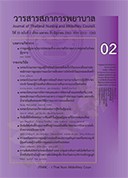Factors Related to Burn Patients’ Post-Discharge Quality of Life
Keywords:
burn patients, quality of life, factors related to, post-dischargeAbstract
Abstract:
Objective: To study the correlation between burn patients’ post-discharge quality of life and the factors of burn injury severity, burn injury pain, wound itchiness, and sleeplessness, during the patients’ follow-up visits to the hospital.
Design: Descriptive correlational research.
Methodology: Based on pre-set criteria, 60 burn patients aged 18 years and older were recruited, each with a history of deep second-degree burns covering at least 10% of the total body surface area. The patients were receiving post-discharge follow-up treatment at two tertiary hospitals in Bangkok. Data were collected from October 2016 to December 2017 by means of a demographic data questionnaire, a brief version of the Burn Specifc Health Scale (BSHS-B), the pain numeric rating scale, the itch numeric rating scale, and the
Insomnia Severity Index (ISI). The data were analysed using descriptive statistics and Spearman’s rank correlation coeffcient.
Results: According to the fndings, most of the subjects were males (63.33%) with a mean age of 43.10 years (SD = +14.19). The sample registered a high average overall quality of life score of 122.83 (= 122.83, SD = 26.09). In the domains of heat sensitivity and work, the subjects showed moderate scores of 10.87 (= 10.87, SD = 6.12) and 8.25 (= 8.25, SD = 5.63), respectively. Most of the subjects (70%) had severe burns, with nearly all (96.67%) suffering from wound itchiness, nearly half (48.33%) from sleeplessness, and 40% from wound pain. Sleeplessness was found to be in a negative correlation with the subjects’ quality of life (r = -0.48, p < 0.01). Burn injury severity, wound pain, and wound itchiness were not found to have any signifcant correlation with the subjects’ post-discharge quality of life (r = -0.13, p = 0.32; r = -0.08, p = 0.55; and r = 0.04, p = 0.77, respectively). Wound pain and wound itchiness, by contrast, had a positive correlation with the subjects’ sleeplessness (r = 0.30, p < 0.05; and r = 0.32, p < 0.05, respectively).
Recommendations: The fndings can be used as a guideline for nurses to coordinate with physicians in promoting sleep in burn patients, with an emphasis on behaviour adjustment and administration of sleep-inducing medications, in order to help burn patients gain suffcient rest and improve their quality of life.
Downloads
References
World Health Organization. WHO health estimates 2014 summary tables: deaths and global burden of
disease [Internet]. 2014. [cited 2016 Nov 21] Available from: https://www.who.int/healthinfo/
global_burden_disease/en/)
Brusselaers N, Monstrey S, Vogelaers D, Hoste E, Blot S. Severe burn injury in Europe: a systematic
review of the incidence, etiology, morbidity, and mortality. Crit care 2010;14(5):1-12.
Ministry of Public Health. Department of Disease Control. Bureau of Epidemiology. Annual epidemiology
surveillance report 2014. Nonthaburi: The Agricultural Co-operative Federation of Thailand; 2015 (in Thai)
Pavoni V, Gianesello L, Paparella L, Buoninsegni LT, Barboni E. Outcome predictors and quality of
life of severe burn patients admitted to intensive care unit. Scand J Trauma Resusc Emerg Med.2010;18(24):1-8.
Goutos I. Neuropathic mechanisms in the pathophysiology of burns pruritus: redefning directions for therapy and research. J Burn Care Res. 2013;34(1):82-93.
Lee AF, Ryan CM, Schneider JC, Kazis LE, Li NC, Rose M, et al. Quantifying risk factors for long-term sleep problems after burn Injury in young adults. Journal of Burn Care & Research. 2017;38(2):e510-e20.
Gabbe BJ, Cleland H, Watterson D, Schrale R, McRae S, Taggart S, et al. Predictors of moderate to
severe fatigue 12 months following admission to hospital for burn: results from the burns registry of
Australia and New Zealand (BRANZ) long term outcomes project. Burns . 2016;42(8):1652-61.
Stavrou D, Weissman O, Tessone A, Zilinsky I, Holloway S, Boyd J, et al. Health related quality of
life in burn patients- a review of the literature. Burns. 2014;40(5):788-96.
Kildal M, Andersson G, Fugl-Meyer AR, Lannerstam K, Gerdin B. Development of a brief version of the
burn specifc health scale (BSHS-B). J Trauma. 2001;51(4):740-6
Koljonen V, Laitila M, Sintonen H, Roine RP. Health-related quality of life of hospitalized patients
with burns-comparison with general population and a 2-year follow-up. Burns. 2013;39:451-7.
Nedelec B, Calva V, Chouinard A, Couture M-A, Godbout E, de Oliveira A, et al. Somatosensory
rehabilitation for neuropathic pain in burn survivors: a case series. J Burn Care Res. 2016;37(1):e37-e46.
Attarian HP, Schuman C. Clinical handbook of insomnia. NewYork: SpringerWien; 2010.
Griffths J, Putthioi S, Pongsuksri M. The General Practitioner Assessment of Cognition; GP-COG
(Thai version): validity and reliability. In: 9th PanPacifc Conference on Rehabilitation cum 21st Annual Congress of Gerontology; 2014 November 29-30; Hong Kong. Kowloon: The Hong Kong Polytechnic University; 2014. pp. B65.
Zhang L-J, Cao J, Feng P, Huang J, Lu J, Lu X-Y, et al. Influencing factors of the quality of life in Chinese burn patients: Investigation with adapted Chinese version of the BSHS-B. Burns. 2014;40(4):731-6.
Faul F, Erdfelder E, Lang A-G, Buchner A. G*Power 3: A flexible statistical power analysis program for
the social, behavioral, and biomedical sciences. Behav Res Methods. 2007;39(2):175-91.
Boonphadh U. Transition conditions related to health status among burn patients in rehabilitation phase
[Thesis]. Nakhon Pathom: Mahidol University; 2005
Nedelec B, Carrougher G. Pain and pruritus postburn injury. J Burn Care Res. 2017;38(3):142-5.
Morin CM, Belleville G, Bélanger L, Ivers H. The insomnia severity index: psychometric indicators to
detect insomnia cases and evaluate treatment response. Sleep. 2011;34(5):601-8.
Brodaty H, Pond D, Kemp NM, Luscombe G, Harding L, Berman K, et al. The GPCOG: a new screening
test for dementia designed for general practice. J Am Geriatr Soc. 2002;50(3):530-4.
Stergiou-Kita M, Grigorovich A, Gomez M. Development of an inter-professional clinical practice
guideline for vocational evaluation following severe burn. Burns. 2014;40(6):1149-63.
Ruangpowpun S, Khuwatsamrit K, Junda T, Kanogsunthrnrat N. Health-related quality of life in burn patients. Ramathibodi Nursing Journal. 2011;18(1):134-51. (in Thai)
Xie B, Xiao SC, Zhu SH, Xia ZF. Evaluation of long-term health-related quality of life in extensive
burns: a 12-year experience in a burn center. Burns.2012;38(3):348-55.








